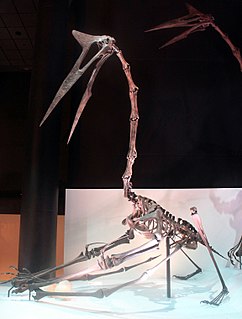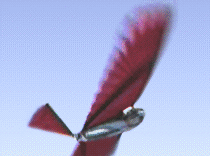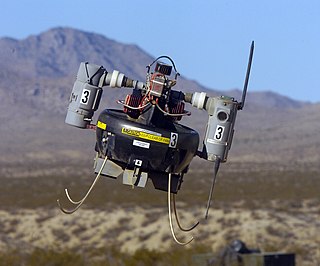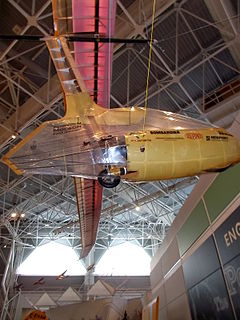Related Research Articles

The Challenger Deep is the deepest known point in the Earth's seabed hydrosphere, with a depth of 10,902 to 10,929 m by direct measurement from deep-diving submersibles, remotely operated underwater vehicles and benthic landers and (sometimes) slightly more by sonar bathymetry.

The Mariana Trench or Marianas Trench is located in the western Pacific Ocean about 200 kilometres (124 mi) east of the Mariana Islands; it is the deepest oceanic trench on Earth. It is crescent-shaped and measures about 2,550 km (1,580 mi) in length and 69 km (43 mi) in width. The maximum known depth is 10,984 metres (36,037 ft) at the southern end of a small slot-shaped valley in its floor known as the Challenger Deep. However, some unrepeated measurements place the deepest portion at 11,034 metres (36,201 ft). If Mount Everest were placed into the trench at this point, its peak would still be under water by more than two kilometres (1.2 mi).

Quetzalcoatlus is a pterosaur known from the Late Cretaceous of North America and one of the biggest known flying animals of all time. It is a member of the family Azhdarchidae, a family of advanced toothless pterosaurs with unusually long, stiffened necks. Its name comes from the Aztec feathered serpent god, Quetzalcoatl. The type and only species is Q. northropi.

Altitude diving is underwater diving using scuba or surface supplied diving equipment where the surface is 300 metres (980 ft) or more above sea level. Altitude is significant in diving because it affects the decompression requirement for a dive, so that the stop depths and decompression times used for dives at altitude are different from those used for the same dive profile at sea level. The U.S. Navy tables recommend that no alteration be made for dives at altitudes lower than 91 metres (299 ft) and for dives between 91 and 300 metres correction is required for dives deeper than 44 metres (144 ft) of sea water. Most recently manufactured decompression computers can automatically compensate for altitude.

An ornithopter is an aircraft that flies by flapping its wings. Designers seek to imitate the flapping-wing flight of birds, bats, and insects. Though machines may differ in form, they are usually built on the same scale as these flying creatures. Manned ornithopters have also been built, and some have been successful. The machines are of two general types: those with engines, and those powered by the muscles of the pilot.

A micro air vehicle (MAV), or micro aerial vehicle, is a class of miniature UAVs that has a size restriction and may be autonomous. Modern craft can be as small as 5 centimeters. Development is driven by commercial, research, government, and military purposes; with insect-sized aircraft reportedly expected in the future. The small craft allows remote observation of hazardous environments inaccessible to ground vehicles. MAVs have been built for hobby purposes, such as aerial robotics contests and aerial photography.

Argentavis magnificens was among the largest flying birds ever to exist, quite possibly surpassed in wingspan only by Pelagornis sandersi, which was described in 2014. A. magnificens, sometimes called the Giant Teratorn, is an extinct species known from three sites in the Epecuén and Andalhualá Formations in central and northwestern Argentina dating to the Late Miocene (Huayquerian), where a good sample of fossils has been obtained.

The University of Toronto Institute for Aerospace Studies is an advanced research facility for aeronautics, aerospace engineering, and robotics located in the Downsview district of Toronto, Ontario, Canada. Established in 1949 by founding Director Gordon N. Patterson, the institute is managed by the University of Toronto Faculty of Applied Science and Engineering and mainly receives funding from governmental agencies such as the National Research Council, the Department of National Defence and the Canadian Space Agency. Notable international sponsors include the European Space Agency, Lawrence Livermore National Laboratory, Max-Planck-Institut für Plasmaphysik, NASA Ames Research Center and the United Kingdom Atomic Energy Authority.

The Piaggio P.180 Avanti is an Italian executive transport aircraft with twin turboprop engines mounted in pusher configuration. It seats up to nine people in a pressurized cabin and may be flown by one or two pilots. The design is of three-surface configuration, having both a small forward wing and a conventional tailplane, as well as its main wing, with the main wing spars passing behind the passenger cabin area.

Air Transat Flight 236 was a transatlantic flight bound for Lisbon, Portugal, from Toronto, Canada, that lost all engine power while flying over the Atlantic Ocean on August 24, 2001. The Airbus A330 ran out of fuel due to a fuel leak caused by improper maintenance. Captain Robert Piché, 48, an experienced glider pilot, and First Officer Dirk de Jager, 28, glided the plane to a successful emergency landing in the Azores, saving all 306 people on board. Most of the passengers on the flight were Canadians visiting Europe or Portuguese expatriates returning to visit family in Portugal.
James D. DeLaurier is an inventor and professor emeritus of the University of Toronto Institute for Aerospace Studies. He is a leader in design and analysis of lighter than air vehicles and flapping winged aircraft.

Mangalore International Airport, is an international airport serving the coastal city of Mangalore, India. It is one of the two international airports in Karnataka, the other being Kempegowda International Airport, Bangalore. Mangalore International Airport is the second busiest airport in Karnataka. In addition to domestic destinations, flights depart daily for major cities in the Middle East. The airport was named Bajpe Aerodrome, when it opened on 25 December 1951, former Prime Minister Jawaharlal Nehru arrived then on a Douglas DC-3 aircraft.
The Flytech Dragonfly is WowWee's entry into remote-controlled flying toy industry. The Dragonfly has been incorrectly billed as the world's first commercially available RC ornithopter. It was actually preceded by several other products, including Hobbytechnik's Skybird, Park Hawk, and Slow Hawk radio controlled ornithopters, and the Cybird radio-controlled ornithopter from Neuros.

The Lancair Legacy, a modernized version of the Lancair 320, is a low-wing two-place retractable-gear composite monoplane, manufactured by the US company Lancair. It is available as a kit that cost US$71,500 in 2011. There is also a fixed-gear version, the Legacy FG. The retractable version of the Legacy cruises at 276 mph at 8,000 ft and the fixed gear version cruises at 215 mph.

West Wratting is a village and civil parish 10 miles southeast of Cambridge in Cambridgeshire. At 390 feet (120 m) above sea level, it can claim to be one of the highest villages in Cambridgeshire.

HPAs are aircraft belonging to the class of vehicles known as human-powered vehicles. Early attempts at human-powered flight were unsuccessful because of the difficulty of achieving the high power-to-weight ratio. Prototypes often used ornithopter principles which were not only too heavy to meet this requirement but aerodynamically unsatisfactory.

Peter Mata'utia-Leifi, also known by the nickname of "Peanut", is a Samoa international rugby league footballer who plays as a centre, fullback or stand-off for the Castleford Tigers in the Betfred Super League.

The Snowbird is a human-powered ornithopter that was built as a project of the University of Toronto Institute for Aerospace Studies (UTIAS). Snowbird was the first human-powered ornithopter to fly straight and level.

Great Lakes Gliding Club (GLGC) is a soaring club located at Tottenham/Ronan Aerodrome, 56.9 km northwest of Toronto, Ontario, Canada.
Treena Livingston Arinzeh is Professor of Biomedical Engineering at New Jersey Institute of Technology in Newark, New Jersey. She is known for her research on adult stem-cell therapy. Arinzeh takes part in the American Chemical Society's Project Seeds program, opening up her lab for high school students from economically disadvantaged backgrounds for summer internships.
References
- ↑ Hein, Treena (2006-10-12). "CBC News In Depth: Science: The world's first flying ornithopter". CBC News. Retrieved 2010-10-13.